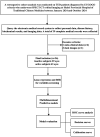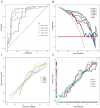Multidimensional predictive model for assessing clinical activity in thyroid eye disease
- PMID: 40697917
- PMCID: PMC12279714
- DOI: 10.3389/fmed.2025.1623286
Multidimensional predictive model for assessing clinical activity in thyroid eye disease
Abstract
Objective: Thyroid eye disease (TED) is an autoimmune disorder with complex inflammatory activity that remains challenging to assess accurately. Current method, mainly the Clinical Activity Score (CAS), exhibits limitations in objectivity and comprehensiveness. This study aimed to develop a multidimensional predictive model integrating clinical parameters, SPECT/CT imaging data, and serum biomarkers, to improve TED activity evaluation.
Methods: This retrospective research included 36 TED patients (72 eyes) diagnosed by EUGOGO criteria who underwent SPECT/CT examination. The Clinical Activity Score (CAS) was used to evaluate inflammatory activity. Variables with significant associations with CAS-defined activity were identified using univariate analysis, and Bayesian shrinkage regression (BSR) and the least absolute shrinkage and selection operator (LASSO) were utilized for variable selection in the primary cohort. Predictive models were constructed and evaluated using receiver operating characteristic (ROC) curves (internally validated via five-fold cross-validation), decision curve analysis (DCA), and calibration curves.
Results: Five predictive models were constructed. The comprehensive Model 4, combining clinical, imaging [EX, maximal SPECT/CT uptake ratio (URmax)], and serum biomarkers (TRAb, RBC), achieved superior diagnostic accuracy (AUC: 91.18%; sensitivity: 0.91; specificity: 0.86). Model 5, retaining variables significant in univariate and multivariate analyses, demonstrated robust performance (AUC: 85.97%) with superior stability during cross-validation (ROC mean: 0.8417). Key predictors included male sex (OR = 11.74), TRAb levels, EX, URmax, and RBC count. SPECT/CT-derived URmax correlated strongly with disease activity, while serum biomarkers complemented imaging limitations.
Conclusion: Multidimensional integration of clinical, imaging, and biomarker data significantly enhances TED activity evaluation compared to single-modality approaches. The multidimensional model offers superior diagnostic accuracy, addressing the limitations of conventional methods. These findings advocate for a holistic approach in TED management.
Keywords: SPECT/CT; clinical activity score; multidimensional model; serum biomarkers; thyroid eye disease.
Copyright © 2025 Li, Zhang, Tian, Hua, Zhai, He and Zuo.
Conflict of interest statement
The authors declare that the research was conducted in the absence of any commercial or financial relationships that could be construed as a potential conflict of interest.
Figures





Similar articles
-
Comparison of Two Modern Survival Prediction Tools, SORG-MLA and METSSS, in Patients With Symptomatic Long-bone Metastases Who Underwent Local Treatment With Surgery Followed by Radiotherapy and With Radiotherapy Alone.Clin Orthop Relat Res. 2024 Dec 1;482(12):2193-2208. doi: 10.1097/CORR.0000000000003185. Epub 2024 Jul 23. Clin Orthop Relat Res. 2024. PMID: 39051924
-
[Predictive value of CT-based tumor and peritumoral radiomics for WHO/ISUP grading of non-metastatic clear cell renal cell carcinoma].Zhonghua Yi Xue Za Zhi. 2025 Jul 15;105(26):2195-2202. doi: 10.3760/cma.j.cn112137-20250226-00460. Zhonghua Yi Xue Za Zhi. 2025. PMID: 40660974 Chinese.
-
Development and validation of a nomogram based on clinicopathological characteristics and multimodal ultrasound parameters for predicting lateral lymph node metastasis in papillary thyroid carcinoma.Gland Surg. 2025 Jun 30;14(6):998-1011. doi: 10.21037/gs-2024-525. Epub 2025 Jun 26. Gland Surg. 2025. PMID: 40671774 Free PMC article.
-
123I-MIBG scintigraphy and 18F-FDG-PET imaging for diagnosing neuroblastoma.Cochrane Database Syst Rev. 2015 Sep 29;2015(9):CD009263. doi: 10.1002/14651858.CD009263.pub2. Cochrane Database Syst Rev. 2015. PMID: 26417712 Free PMC article.
-
Signs and symptoms to determine if a patient presenting in primary care or hospital outpatient settings has COVID-19.Cochrane Database Syst Rev. 2022 May 20;5(5):CD013665. doi: 10.1002/14651858.CD013665.pub3. Cochrane Database Syst Rev. 2022. PMID: 35593186 Free PMC article.
References
LinkOut - more resources
Full Text Sources

